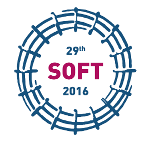Speaker
Kohei Hamaguchi
(Division of Sustainable Energy and Environmental Engneering)
Description
It is desirable to develop tungsten (W) diverter in Tokamak-type nuclear fusion reactor including the International Thermonuclear Experimental Reactor (ITER). W has the highest melting point in all metals and thus is a promising material of the diverter. Since the diverter will repetitively undergo high heat flux of 100MW/m2 2 at least in a few tens of millisecond or less when plasma disruption occurs, it is predicted that W of the surface material would be molten and solidified during the operation. The surface shape of the W diverter after or during such repetitive heat load has the strong influence on the lifetime of it due to change of the thermal resistance. Thus, it is important to establish the method predicting the W behavior for the W diverter design. However, it is difficult to evaluate it with phase change during short time only from an experimental study. We have been developing simulation method which can predict a metal behavior with phase change for laser processing and our simulation method can be extended to the W diverter. In our simulation, equation of continuity, momentum, energy and equation of state (EOS) are solved by C-CUP method and then multi-phase phenomena can be considered. Firstly, we evaluated aluminum (Al) and nickel (Ni) behaviors irradiated by short pulsed laser using SESAME as EOS. It was confirmed that our simulation method could treat phenomena inner or outer materials such as shock wave propagation and ablation. After that, we tried to introduce GRAY-EOS in governing equations instead of SESAME in order to simulate various materials including W, because we didn’t have any database of SESAME other than Al and Ni. The simulation of W irradiated by laser is conducted using our simulation method and the result is compared with that in the experiment of Ueda et al..
Co-authors
Eiji Hoashi
(Division of Sustainable Energy and Environmental Engneering, Graduate School of Engineering Osaka University, Osaka, Japan)
Kenzo Ibano
(Division of Electrical, Electronic and Information Engineering, Graduate School of Engineering Osaka University, Osaka, Japan)
Kohei Hamaguchi
(Division of Sustainable Energy and Environmental Engneering, Graduate School of Engineering Osaka University, Osaka, Japan)
Takafumi Okita
(Division of Sustainable Energy and Environmental Engneering, Graduate School of Engineering Osaka University, Osaka, Japan)
Yoshio Ueda
(Division of Electrical, Electronic and Information Engineering, Graduate School of Engineering Osaka University, Osaka, Japan)

